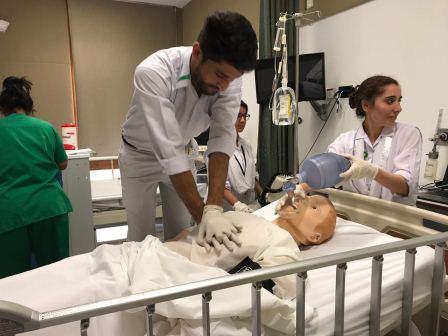Mock Drill: Simulator Mediated Activity for Resuscitation Training (SMART)
This story is written by Azmat Khan, Assistant Professor, School of Nursing and Midwifery (SONAM), Pakistan
I am a graduate of AKU-SONAM-Pakistan, and I have been teaching in an undergraduate nursing program (BScN) for several years. I teach Bachelor of Science in Nursing (BScN) fourth-year program's clinical course where students are expected to work in the emergency department (ED) and provide care to patients in vulnerable situations. Over the years, I have observed that the students usually avoid performing Cardio-Pulmonary Resuscitation (CPR) in emergency situations. They feel anxious and fearful even while observing CPR and tend to stay far from the resuscitation team. I decided to use a Simulator-Mediated Activity for Resuscitation Training (SMART) in the simulation lab at CIME, to reduce their anxiety and enhance their clinical skills. I purposely use mannequin (Resusci Anne Simulator) as the simulator has high-quality airway management with endotracheal tubes, spontaneous breathing, live defibrillation and synchronized ECG, IV insertion, blood pressure and pulse monitoring, Quality Chest compression feedback on the SimPad, voice, lung and heart sounds for basic simulation training. I teach the session in four phases namely: pre-session briefing, orientation, implementation, and modelling and debriefing.
Pre-session briefing
This is conducted, a day prior to actual mock drill a pre-session briefing. I engage students in discussions around life-threatening arrhythmias, algorithms and resuscitation team roles.
Orientation
In this phase, I divide students into two groups (Group A and B), and orient them on simulated ED room, mannequin, simulator and equipment (Crash Cart, Defibrillator, Ambo bag, Oxygen flow-meter).
Implementation
I provide a scenario to students in Group A and they share roles as a resuscitation team. I regulate SimPad to provide them with a specific situation and they run a Mega Code on simulated mannequin according to the given scenario (used American Heart Association testing mega code scenarios). During resuscitation activity, I provide different arrhythmias through SimPad and according to these arrhythmias students select an appropriate algorithm and run the code.
Also, I assign a student from Group B to video-record the whole activity while the rest of Group B members observe critically from the adjacent observation room and make notes on Group A's activity. After the performance of one group, roles of both the groups are switched.
Modelling and Debriefing
After the performance of both groups, we discuss the activity. Subsequently, I model CPR for the students on the mannequin having the pre-set arrhythmias. The students then demonstrate CPR and get feedback on their performance and I re-demonstrate where necessary. Thereafter, we debrief the session using the recorded videos where students reflect and discuss what and how they have learned and how can they perform better.

Post-SMART evaluation
Students' feedback on the use of SMART was sought and 81% of students indicated that the mock-drill enabled them to meet their objective of identifying cardiac dysrhythmias and performing algorithms in their resuscitation teams. 94% were satisfied with the learning methodology used in the mock-drill and 93% of the students found SMART useful in enhancing their knowledge and skills regarding CPR. Some students shared:
"The mock drill was fruitful and I suggest more of these kinds of mock drills as practice makes a person perfect".
"SMART mock-drill was a good initiative as it helped me reduce my anxiety towards CPR. It should be organized for all BScN students."
"The drill was a nice practice to give some exposure to what we might face in the critical area".
Conclusion
In nursing education, simulation-based technology and simulation environment plays a crucial role in providing students with a hands-on practice where they can engage in recursive practice and learn through their mistakes which contribute towards becoming a competent and a safe nurse. Next time I teach the course again, I plan to go a step further and take the learners to the Emergency Room to enable them to apply their learning in the real-life critical area. My students and I have benefitted greatly using the SMART approach. I recommend the SMART approach to all faculty who teach CPR to health care professionals.


